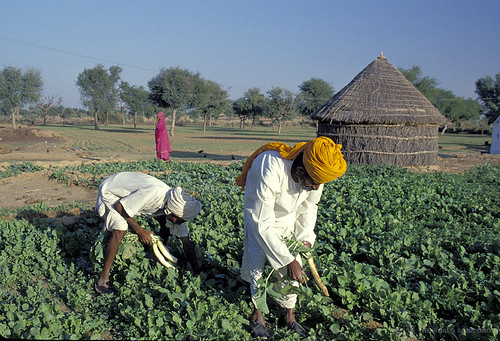July 2012
 |
| Harvesting in India. Photo by World Bank Photo Collection on Flickr |
As estimated 250 million Indians don't
have enough to eat. One-fifth of its people are malnourished: this
is double the rate of other developing countries like Vietnam and
China.
Yet, the Indian government has had a
scheme in place to deal with this problem since the 1960s. It buys
up all the wheat and rice its farmers produce, giving them a higher
and more consistent price than they would get on the open market.
The grain thus acquired is delivered to subsidised state shops. Needy families are given ration cards by the state with which they can buy cheap rice and grain from these shops. The poor in India have, therefore, had a cushion against the recent rising food prices blamed on increases in the cost of oil and fertilisers, land degradation, climate change, competition from biofuel crops, and an on-going dietary switch to animal products.
Over the last two decades, there has
been an almost 50% increase in food production in India. In May this
year, the government had amassed a stockpile of 71 million tons of
grain, up 20% from 2011. The storage facilities, or 'godowns', are
so vast they are “really hard to photograph. The buildings go on
as far as the eye can see” (Stone). India grows so much food that
the godowns can't take it all: stacks of rotting rice and wheat can
be seen sitting beside the highway in some rural areas.
Growing the crops in the first place
uses huge up huge volumes of precious water. What can't be stored is
exported at a loss, while some ends up in distilleries being turned
into liquor.
In other words, India's
paradox of plenty is nothing to do with its population outpacing its
agriculture, any more than is the case in wealthy, obese America
where 14% of the people suffers from food insecurity.
Glen Davis Stone, US
Professor of Anthropology and Environmental Studies, asked: “Just
exactly how are their (GM) technologies going to feed hungry Indians
when over 30 million tons of excess grain can't?”.
So what has gone
wrong in India? Put simply:
- Pervasive corruption
- Mismanagement
The poor face stiff bureaucratic
hurdles to qualify for ration cards. Those on low income (more than
2,000 rupees, about $36, a month) don't qualify regardless of how
many mouths they have to feed and what rent they have to pay to keep
a roof over the family's head.
And, bribes may even be needed to
'purchase' a ration card.
Even when the subsidised
food has been accessed, the diet of those dependent on it is far from
healthy. The quality and quantity of grain on offer is often
substandard. Nothing except rice and wheat can be bought amid fears
that, if fresh produce were available under the scheme, men would
trade them for liquor and tobacco and their families would still be
deprived.
And, while India struggles
and pro-biotech industries and governments try to 'solve' the problem
with GM food (see WHAT YOU CAN DO below),
what do the people of other developing countries think about the GM
issue? As far back as 1998 a delegation from 18 African countries to
the United Nations Food and Agricultural Organization had this to
say:
“We strongly object that the image of the poor and hungry from our countries is being used by giant multinational corporations to push a technology that is neither safe, environmentally friendly nor economically beneficial to us ... it will destroy the diversity, the local knowledge and the sustainable agricultural systems that our farmers have developed for millennia, and that it will thus undermine our capacity to feed ourselves.”
OUR COMMENT
No matter how much GM food
you
eat, you won't save anyone in developing or developed countries from
hunger or malnutrition. You might even help to cause
it: see THE DARK SIDE OF GOLDEN RICE - July 2012.
WHAT YOU CAN DO
Some positive
action
on your part to help the poor in developing countries, would be to
persuade the UK government to come to its senses. Our Minister for
Universities and Science has just announced new funding of £250
million to launch a new Green Revolution to feed the world in which
GM
crop science will be fundamental.
Perhaps you could pose Prof. Stone's question above to our, no doubt
well-meaning, Minister?
SOURCES:
- George Freeman MP, Government announces GBP250m new funding for UK Bio-economy, http://blog.georgefreemean.co.uk, 24.05.12
- Michael Antoniou, Claire Robinson, John Fagan, GMO Myths and Truths, Section 7, Feeding the World, June 2012
- Vikas Bajaj, As Grain Piles U, India's Poor Still Go Hungry, New York Times, 7.06.12
- Glenn Davis Stone, Feeding Hungry Indians, Field Questions, 16.06.11
- Feeding the World with GM Crops: Myth or Reality?, GM Freeze, June 2008
Good article. Very clear, although it might be thought to imply that GM crops can increase agricultural productivity - a claim for for which there is precious little evidence.
ReplyDelete